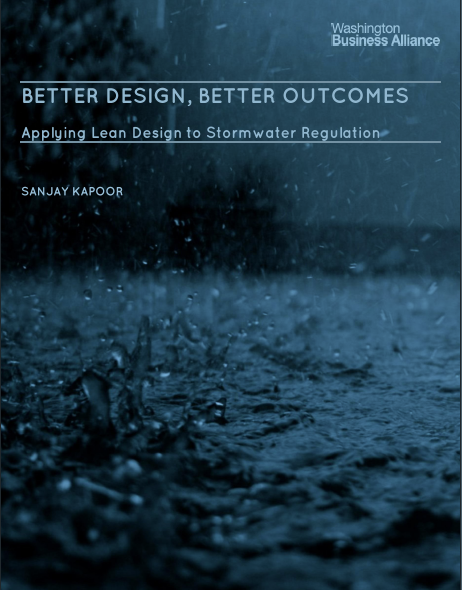Better Design, Better Outcomes uses lean techniques such as value stream mapping to guide the design of processes underlying stormwater regulation. Examining regulation in this manner helps government ease the burden on business and helps business ease the burden on government, as they become partners in the common quest of improved water quality. The report was authored by Sanjay Kapoor.
Download Better Design Better Outcomes (PDF).
Executive Summary
 Pollution from stormwater runoff is an increasing problem in Washington State and continues to impact already stressed ecosystems. According to Jay Manning, former director of the Washington Department of Ecology and chief of staff to the governor, “Stormwater runoff is the number one environmental issue Washington State faces.”
Pollution from stormwater runoff is an increasing problem in Washington State and continues to impact already stressed ecosystems. According to Jay Manning, former director of the Washington Department of Ecology and chief of staff to the governor, “Stormwater runoff is the number one environmental issue Washington State faces.”With an initial focus on the stormwater permitting process, the Washington Business Alliance convened a group of experts familiar with different parts of this process to collectively explore it. Participants included regulators from government agencies (federal, state, and local), municipalities and businesses, and consultants involved in negotiating the process. We employed Lean techniques, as well as leveraged accounting methods that capture total cost.
Recommendations come in two parts:
- An improved permitting process that would require
- reorientation and reengineering of the regulatory process around the outcome of better water quality;
- a “complier-centric” process;
- a lead agency that functions as a single point of contact and process owner;
- a single point of fee collection, reducing the complier’s administrative and financial burden;
- mapping and sharing of the end-end process with “vital few” metrics; and
- an information-sharing dashboard that balances privacy with public transparency.
- A “better design” phase, to eliminate the need for permitting, by making available expertise on
- avoiding stormwater discharge through Low Impact Development (LID) techniques; and
- cost-benefit analyses that capture all costs, including those typically externalized, using natural capital accounting.
We are optimistic that this application of lean concepts married with principles of total accounting is well suited to combat challenges not only in the area of stormwater regulation but in other domains as well.
